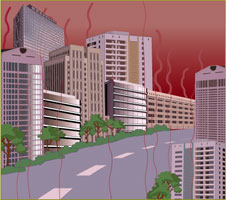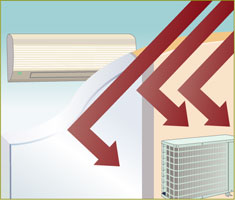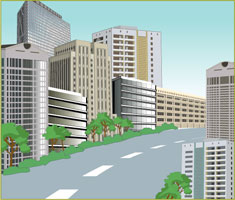Heat-Island Mitigation: Technologies for Reducing Air Conditioning Loads by Using Building Envelope Systems
 @
@ @
@
@Verification is implemented for technologies regarding building envelope systems which can be retrofitted to buildings of offices, stores, houses, etc., and which reduce artificial exhaust heat by reducing indoor air-conditioner cooling loads, and contribute to heat island mitigation (excluding measures concerning greening). Solar shading window films to reduce incident light, and highly reflective heat shield coatings to enhance solar reflectance ratio are representative technologies. However, regardless of their mitigation principles, technologies that meet the above objective are widely targeted.
Heat-Island Mitigation Technology Field (Technologies for Reducing Air Conditioning Loads by Using Building Envelope Systems)
- Heat-Island phenomena are phenomena where the ambient temperature of the central area of a city becomes locally high (island-shaped temperature distribution). They are mainly caused by [1] increase of artificial heat exhausted from human activities such as air conditioning systems, electric apparatuses, and automobiles, and [2] increase of artificial coverings over the ground by decrease of green areas and water surfaces and by increase of buildings and pavements. The phenomena have come to gather attention recently as an environmental problem specific to cities.
- Ministry of the Environment estimates that, among heat (sensible heat to the air) having an effect on temperature rise in Tokyo's 23 wards, heat caused by artificial exhaust heat occupies about 50%, and half of the artificial heat is generated from buildings (air conditioner, etc.).
- Among measures to reduce artificial exhaust heat, measures that can reduce the heat exhausted from existing equipment and buildings without renewal of buildings themselves, air conditioner equipment, etc., can be easily introduced compared with other heat island mitigation measures, because construction work is not necessary, and a problem of heavy loads to the building does not arise, which is different from the cases of greening.
Reference: What is the gOutline of the Countermeasures against Heat Island Phenomena"?
@In the gOutline of the Countermeasures against Heat Island Phenomena" laid down in March 2004, basic policies are presented to appropriately promote efforts of the national government, local governments, enterprises, residents, etc., for heat island mitigation measures, and specific measures to be taken are summarized. Pillars of the countermeasures include: [1] reducing artificial exhaust heat, [2] improving coverings over the ground, [3] improving urban forms, and [4] improving lifestyles.